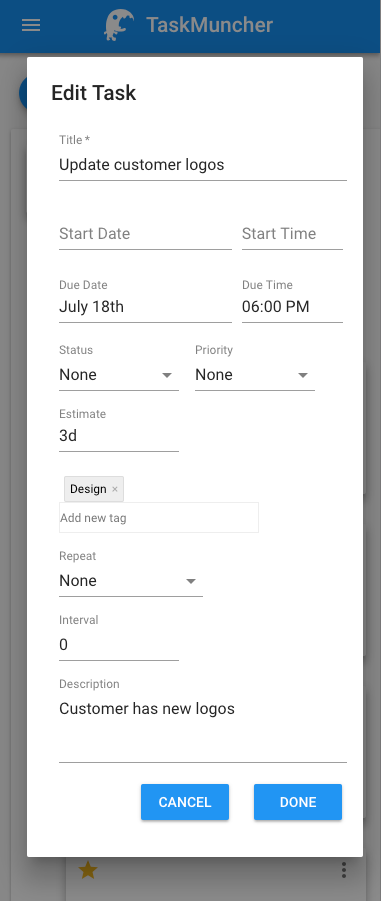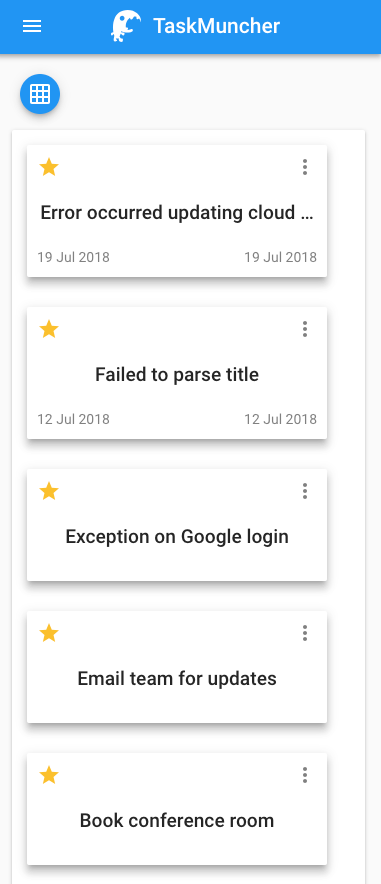TaskMuncher Overview
by John Vincent
Posted on October 28, 2018
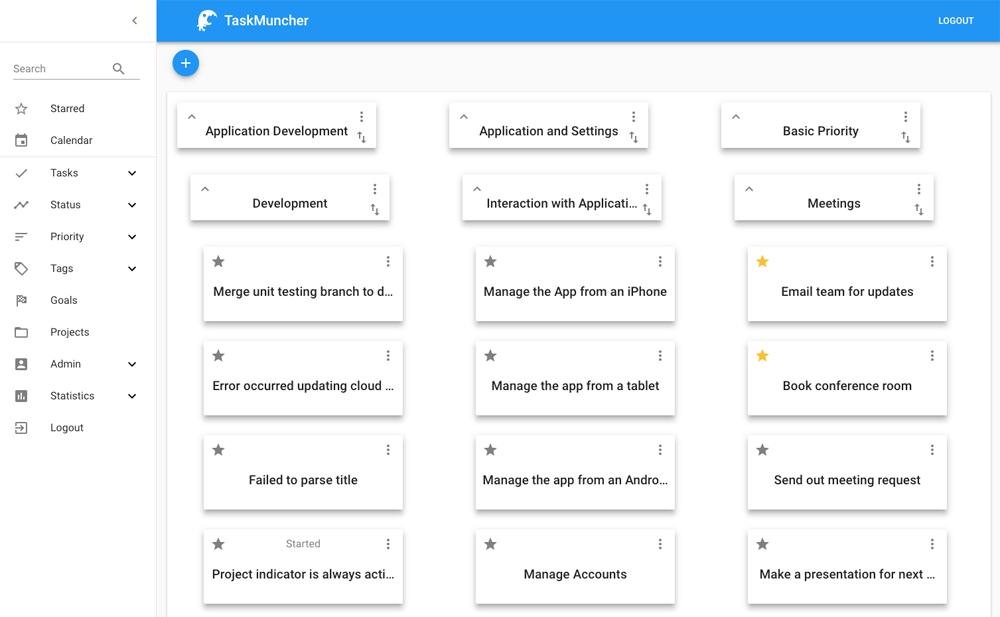
TaskMuncher
TaskMuncher is a Task Management Productivity application.
TaskMuncher is the easiest way to get it done, whether you're making a shopping list, planning a holiday or managing multiple work projects.
Use TaskMuncher to organize and keep track of everything so you can get it all done and enjoy more peace of mind.

Live Deployment
Demo login
email: demo@taskmuncher.com
password: 123456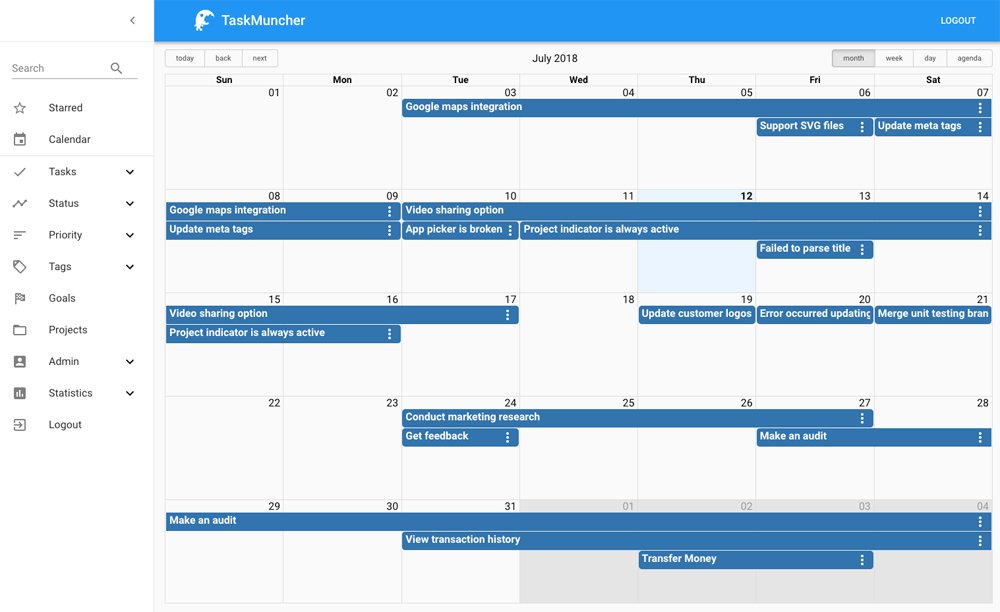
Technical
TaskMuncher is built using the MERN stack. The front-end is built using React, Material-UI, Redux, HTML5, Sass and CSS3, the server-side using Node with Express as the web server and Mongo as the database.
TaskMuncher is fully responsive, adapting for mobile, table and desktop viewports.
All routing is handled in the front-end by React
Extensive form validation and error handling is demonstrated throughout the app. On the front-end, field type, value, length etc is validated using HTML5, React and Redux. On the server-side, JOI performs detailed validation and a Mongoose schema provides further error checking for field values and uniqueness.
A fully-featured user registration system is integral to the application, with user registration and username / password recovery functionality provided.
TaskMuncher supports Google Authentication
Server-side email functionality is provided by a Nodemailer OAuth 2.0 implementation, using Google Gmail
An extensive API has been built to provide database access to the TaskMuncher App using Express, with 27 separate endpoints constructed.
TaskMuncher is fully unit tested on the front and server-side. For React testing, Jest has been used. For the server-side, Mocha and Chai, with extensive use of the Faker library to mock-out dependencies.
User authentication uses Json Web Tokens JWT
All client and server communications are performed using https.
TaskMuncher fully implements Google Analytics
TaskMuncher fully supports Google Webmaster Tools
TaskMuncher is deployed to an Ubuntu 16.04 droplet at Digital Ocean and kept running using Pm2
TaskMuncher at AWS is also deployed to an Ubuntu 16.04 droplet at AWS for test purposes.
TaskMuncher resources are served from Nginx Server with a reverse proxy to pass certain requests to a Node Express Server.
The Ubuntu 16.04 droplet at Digital Ocean can only be accessed with SSH from a particular client. All other access is disabled.
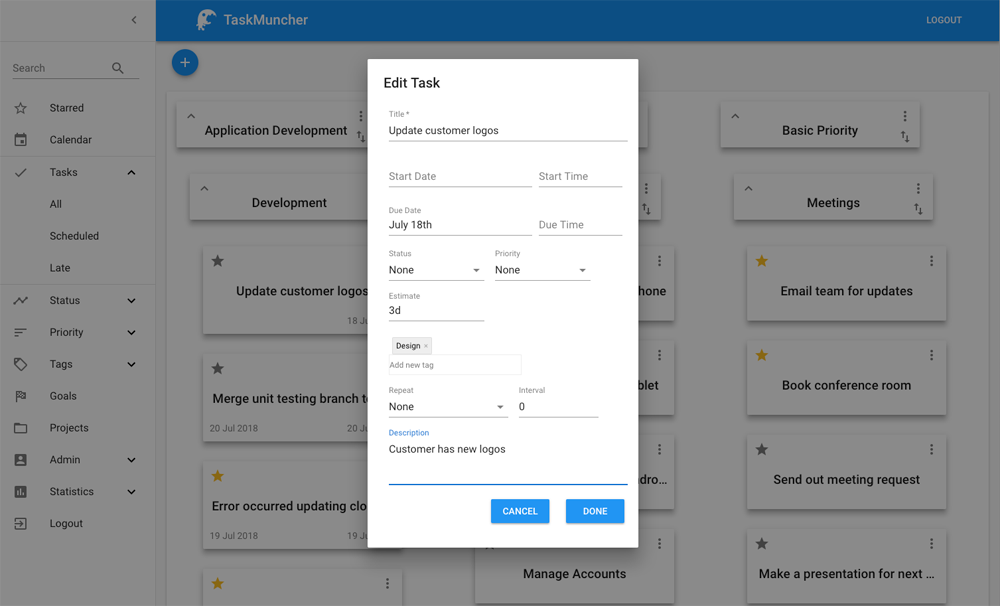
Deploy TaskMuncher
TaskMuncher is deployed to a Digital Ocean Droplet.
TaskMuncher is also deployed to an AWS EC2 instance.
The following describe a series of tasks. They should be performed in the order shown.
- Create Ubuntu Droplet at Digital Ocean
- Digital Ocean - Install Mongo
- Digital Ocean - Install Nginx
- Configuring Domains at Google Domains
- Configure non-SSL Nginx at Digital Ocean
- SSL Certificates - Let’s Encrypt & Nginx
- Configure SSL Nginx at Digital Ocean
- Backup TaskMuncher from Digital Ocean
- Deploy TaskMuncher React App to Digital Ocean
- Create Sitemap
- Google Webmaster Tools
- TaskMuncher Images and Favicons
- Facebook Application Id
- Configuring Meta Tags
- Adding Google Analytics
- Google Gmail Configuration
- Google Authentication
Maintenance
The following describe tasks required for the maintenance of TaskMuncher at Digital Ocean.
Update SSL Certificates to Ubuntu at Digital Ocean
Maintaining Droplets at Digital Ocean
Production Problems
TaskMuncher React Production Issues
Website Validation
The following describe tasks required for the validation of TaskMuncher at Digital Ocean.
TaskMuncher Website Validation
TaskMuncher Version Updates
Update TaskMuncher V2 to Webpack v4, Babel v7, Material-UI v3
Update TaskMuncher V3 to use BrowserRouter rather than HashRouter
Update TaskMuncher V4 to Progressive Web App
TaskMuncher Updates
Add TaskMuncher to Material-UI Showcase
Deploy TaskMuncher to AWS
Technologies
Client
- React
- React DnD
- React Router
- Material-UI
- Progressive Web App
- Redux
- Redux Devtools
- Styled Components
- HTML5
- CSS3
- Sass
- Webpack
- Jest
- Enzyme
- Eslint
- Prettier
- Balsamiq
Server
- Node
- Express
- Mongo
- Mongoose
- JWT
- JOI
- Mocha
- Chai
- Winston
- Morgan
- Mailgun
- Gmail OAuth 2
- Google Authentication
- JS Doc
- Eslint
- Prettier
Production Deployment
Testing Deployment
For a simple application deployed from a single Github repository:
TaskMuncher has multiple Github repositories and thus is not suitable for Heroku. The testing deployment is another droplet at Digital Ocean, in effect a duplicate of the actual production environment.
Wireframes
Wireframes built using Balsamiq may be downloaded here
TaskMuncher Project
Purpose of App
Task management tool. Allow user to easily organize and manage tasks by goals and projects. Provide a calendar to easily manage tasks and events.
Proposed Name
TaskMuncher
User Stories
As a user, I should be able to:
- sign up
- remove my account
- log in
- change my password
- reset my password
- add, edit, delete, clone a goal
- add, edit, delete, clone a project
- add, edit, delete, clone a task
- search and be presented with a list of goals, projects and tasks containing the search expression
- move goals
- move projects within a goal or to another goal
- move tasks within a project or to another project
- change status of a goal or a project
- allow starred tasks
- list starred tasks
- list all tasks
- list scheduled tasks
- list late tasks
- differentiate between scheduled task and an event
- edit task status
- list tasks by status, including none, started, completed, planning and waiting
- edit task priority
- list tasks by priority, including none, top, high, medium and low
- edit task tags
- list tasks by tags
- add, edit, delete task start date/time
- add, edit, delete task due date/time
- repeat tasks with an interval
- show tasks on a calendar
- add, edit, delete tasks in a calendar
- authenticate with Google
- authenticate with Facebook
- request help
- show added tasks for various time frames
- show updated tasks for various time frames
- show completed tasks for various time frames
- administration section allowing an administrator full access to all data
Descope
A list of user stories to be supported in the MVP:
As a user, I should be able to:
- add, edit, delete a task
- list tasks
- add a goal
- add a project
Other requirements:
- Fast (page speed score)
- Responsive
- SEO friendly
User Screens
List of the distinct screens or pages that your end user will interact with.
Screen for:
- add, edit, delete a task
- list tasks
- add a goal
- add a project
User Journey for Each Screen
For each screen, specify the way(s) the user journeys through the page. Use User Flows
A user flow describes:
- what the user sees
- what they do
- what they see next after doing that thing
User Journey - Screen for add, edit, delete a task
User has a list of articles. User selects an article User is presented with the article.
User Journey - Screen for selecting a news channel User requests a list of news channel. User requests a news channel. User sees latest news from that channel
User Journey - Screen for adding a news channel User requests a list of news channels. User adds news channel. If error, show error. Else, add news channel. Add news channel to list of news channels.
User Journey - Screen for adding news channel to my channels User requests a list of news channels. User requests channel be added to my channels. List of My Channels is updated. List of My Channels is shown.
Project Requirements
Server must
- use Node/Express
- use a db
- have RESTful API and/or
Socket.iolayer - serve static assets
- have comprehensive testing
- have high code quality. Among other things that means
- choosing good variable names
- writing functions that have a single responsibility
- consistently following a style guide
- well architected
Client must have
- polished UI
- responsive
- follows accessibility best practices, for instance, all inputs wrapped in forms, all inputs have labels
- bundled and optimized for delivery
- comprehensive testing
- high code quality
- well architected
- cross browser tested, with support for current version of popular browsers
Implement MVP
- CI and Deployment. Set up continuous integration with Heroku and Travis CI right away, and have tests automatically run each time you push to GitHub
- Git and GitHub. Develop each user story with a feature branch and when ready to deploy to your production environment, do a pull request from your feature branch into master, triggering an automatic deploy from Travis CI.
- Start with mock data. Define API resources and the schema for the data they return as code up the front end.
- Both server and client side unit testing. As complete a feature or support a user story, write tests. Strive for comprehensive test coverage for both server- and client-side code. At a minimum, that means testing routes, components, actions, and reducers.
Gather User Feedback and Iterate
Now that MVP is live, it's time to get user feedback. The sorts of things you're going to want to find out about are:
- Do my users think the app is interesting or valuable?
- Did my users use the app as I intended?
- Did my users encounter any bugs or broken features?
- Did my users understand how to use the app?
- Get feedback from real life people who are not you and your mentor.
Then, based on what you learn, do a round of iteration on your MVP to address any issues that came up.
Note findings from user feedback. Note what, if anything, I did about it.
Feedback
New user should be stepped through the process. Add a goal and a project, then add a task.
under status, categories which are empty shouldn't be shown at all
Would be cool that instead of clicking the 3 dots and then editing something, that default action by clicking on something is edit. This would be better user experience. Now you can't really click on anything and feels strange.
I think that it would be better if the list view is the default one and the grid one secondary
When I want to expand a project, I have to click on the arrow pointing down. It would be just better that this happens on clicking on the project itself.
List view is confusing when browsing projects etc. It doesn't imply which list I'm viewing (from which project, it seams that all of them aggregated in the same list)
Would be nice to create a task by using the calendar, by clicking on some specific date
Also on your landing page, you should probably have 3 or 4 items per row (those things with icons and description) aside those comments and generally some UX stuff.
Amazing job, this is a very valuable project for your CV. Also feel super fast and fluid.
Digital Ocean
- Building and deploying MyTunes to johnvincent.io
- Building and deploying React Github Helper App to johnvincent.io
- Configuring Google Domains
- Create Ubuntu Droplet at Digital Ocean
- Create Ubuntu Droplet at Digital Ocean
- Deploy Feediator to Digital Ocean
- Deploy to Droplet
- Feediator Overview
- Feediator Project
- Maintaining Ubuntu Droplet
- Maintaining Ubuntu Droplet
- Overview of Deployment of a Node API Server
- Overview of johnvincent.io
- Overview of johnvincent.io Jekyll website
- Overview of React Gomoku
- Overview of React Hangman
- Overview of React Lights Out
- Overview of React Yahtzee
- TaskMuncher Overview
Taskmuncher
- Backup TaskMuncher from Digital Ocean
- Configure HTTP Nginx
- Configure HTTPS Nginx
- Configuring Google Domains
- Configuring Meta Tags
- Create Site Map
- Create SSL Certificates
- Create Ubuntu Droplet at Digital Ocean
- Deploy TaskMuncher React App to AWS
- Facebook Application Id
- First time deploy TaskMuncher React App to Digital Ocean
- Google Analytics for TaskMuncher
- Google Authentication
- Google Gmail Configuration
- Google Webmaster Tools
- Install Ubuntu Mongo
- Install Ubuntu Nginx
- Mailgun
- Maintaining Ubuntu Droplet
- Material-UI Showcase
- Optimizing TaskMuncher with Webpack 4
- React Production Issues
- TaskMuncher Images and Favicons
- TaskMuncher Overview
- TaskMuncher Performance
- TaskMuncher Website Validation
- Update SSL Certificates
- Update TaskMuncher for Lighthouse Findings
- Update TaskMuncher to be a Progressive Web App
- Update TaskMuncher to use React BrowserRouter
- Update TaskMuncher to Webpack v4, Babel v7, Material-UI v3

